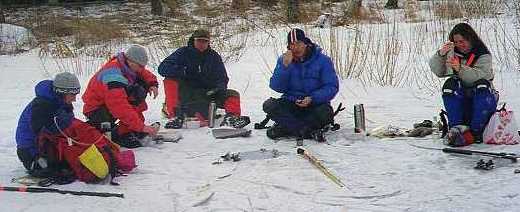
It was time for my introduction to the Swedish sport of långfärdskridsko or long-distance skating. I had contacted some Swedish skaters by email, and we arranged to meet in the suburb of Ekerö. It was a short drive in Pam's car from Ekerö to the shore of island-studded Mälaren, Sweden's third-largest lake. I salivated at the sight of a lake 100 miles long, frozen solid from end to end! We jumped out of the car, grabbed our backpacks, and began weighing ourselves down with Swedish safety equipment. Our hosts -- tour leaders Johan Porsby and Carina Borg from Stockholm; and Peter Dahlén and Morgan Filipsson from Linköping -- had thoughtfully brought along an extra set of equipment for me.
Swedish skates are unlike anything we use here in the USA. The long, detachable blades are designed to clamp onto the soles of telemark ski boots. So you can ski and skate in the same pair of comfortable boots. And you never have to lace up your skates sitting in the snow on a frigid lakeshore, as I did when I was a kid. Just put your warm boots on at home, and clamp on the blades when you get to the ice.
I put a pair of isdubbar around my neck. These devices, known to North Americans as "ice claws", are what you use to haul yourself out of the water if you fall through the ice. My companions were all experts in this technique -- they had all gone through the ice at least once, and moreover, they were proud of it! "It doesn't count unless you get wet above your waist," Carina told me. "Then you have to change all your clothes!"
Next, I loaded my backpack full of spare clothes sealed up in plastic bags, tossed in a rescue rope on top, hoisted it up onto my back and tightened the waist strap. The idea is that if you go through the ice, the air trapped inside the plastic bags will turn your backpack into a flotation device and keep your head above water.
It was reassuring to know that if the ice collapsed underneath me, I could pull myself out with my isdubbar, strip naked on the windswept ice, and change into dry clothes before hypothermia set in. But it was a scenario I preferred not to contemplate. And that's why Swedish skaters round out their equipment list with a pair of ispikar or "ice poles" -- like downhill ski poles with the baskets removed -- which you jab straight down into the ice to test its strength. If your ispik goes through on the first jab, the ice is too weak. If it takes two or three jabs, your safety margin is razor-thin. Four or more, and you're OK. Ispikar also help you keep your balance on rough, bumpy ice.
In spite of all the esoteric gear, and the polite lecture on safety techniques, nothing could detract from the smoothness of the ice and the unspoiled scenery surrounding us. We skated in pairs across an arm of Mälaren, talking nonstop, mostly in English since my hosts were all bilingual and my knowledge of Swedish was minimal. Our route took us to the island of Björkö, site of the ancient Swedish village of Birka, where we ate a picnic lunch on the ice in the sheltered harbor. We took off our skates, and out of our backpacks came foam pads to sit on, plastic tubs full of sandwiches, and thermoses of hot coffee, tea and blåbärssoppa (blueberry soup). For dessert we had semlor, the Swedish version of hot cross buns, with a delicious almond cream filling. After lunch we followed a meandering route back to the car, testing our speed against each other and talking with growing excitement about tomorrow's race. Johan, Carina, Peter and Morgan were all racing too.
Back in the car, Pam and I dashed quickly up to Lake Ekoln for a sneak preview of the race course. As we put on our skates and headed out, a convoy of three snowplows was sweeping the inbound track. I skated out a few kilometers, then turned around and sprinted. I clocked my speed at 1 minute 57 seconds per kilometer -- a hair under 20 MPH. I was ready!
Twelve of us met that night for a carbo-loading pasta feast in downtown Stockholm. At the table were six Swedes, two Americans, and four Dutch skaters who had just flown in from Amsterdam. The multilingual conversation turned inevitably to the "mother of all skating tours," the Elfstedentocht, a 200-kilometer Dutch tour that all of us either have already skated, or yearn desperately to skate. (I count myself in the latter group.) After dinner we headed our separate ways to catch up on sleep.
Originally published in two Vermont daily newspapers, the Sunday Rutland Herald and Barre-Montpelier Times-Argus.
Comments? jamie@nordicskater.com
Return to main Swedish skating page